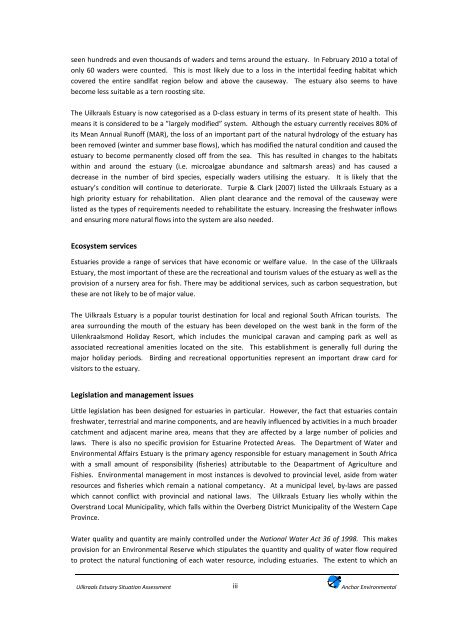Download PDF - Anchor Environmental
Download PDF - Anchor Environmental
Download PDF - Anchor Environmental
Create successful ePaper yourself
Turn your PDF publications into a flip-book with our unique Google optimized e-Paper software.
seen hundreds and even thousands of waders and terns around the estuary. In February 2010 a total of<br />
only 60 waders were counted. This is most likely due to a loss in the intertidal feeding habitat which<br />
covered the entire sandlfat region below and above the causeway. The estuary also seems to have<br />
become less suitable as a tern roosting site.<br />
The Uilkraals Estuary is now categorised as a D-class estuary in terms of its present state of health. This<br />
means it is considered to be a ”largely modified” system. Although the estuary currently receives 80% of<br />
its Mean Annual Runoff (MAR), the loss of an important part of the natural hydrology of the estuary has<br />
been removed (winter and summer base flows), which has modified the natural condition and caused the<br />
estuary to become permanently closed off from the sea. This has resulted in changes to the habitats<br />
within and around the estuary (i.e. microalgae abundance and saltmarsh areas) and has caused a<br />
decrease in the number of bird species, especially waders utilising the estuary. It is likely that the<br />
estuary’s condition will continue to deteriorate. Turpie & Clark (2007) listed the Uilkraals Estuary as a<br />
high priority estuary for rehabilitation. Alien plant clearance and the removal of the causeway were<br />
listed as the types of requirements needed to rehabilitate the estuary. Increasing the freshwater inflows<br />
and ensuring more natural flows into the system are also needed.<br />
Ecosystem services<br />
Estuaries provide a range of services that have economic or welfare value. In the case of the Uilkraals<br />
Estuary, the most important of these are the recreational and tourism values of the estuary as well as the<br />
provision of a nursery area for fish. There may be additional services, such as carbon sequestration, but<br />
these are not likely to be of major value.<br />
The Uilkraals Estuary is a popular tourist destination for local and regional South African tourists. The<br />
area surrounding the mouth of the estuary has been developed on the west bank in the form of the<br />
Uilenkraalsmond Holiday Resort, which includes the municipal caravan and camping park as well as<br />
associated recreational amenities located on the site. This establishment is generally full during the<br />
major holiday periods. Birding and recreational opportunities represent an important draw card for<br />
visitors to the estuary.<br />
Legislation and management issues<br />
Little legislation has been designed for estuaries in particular. However, the fact that estuaries contain<br />
freshwater, terrestrial and marine components, and are heavily influenced by activities in a much broader<br />
catchment and adjacent marine area, means that they are affected by a large number of policies and<br />
laws. There is also no specific provision for Estuarine Protected Areas. The Department of Water and<br />
<strong>Environmental</strong> Affairs Estuary is the primary agency responsible for estuary management in South Africa<br />
with a small amount of responsibility (fisheries) attributable to the Deapartment of Agriculture and<br />
Fishies. <strong>Environmental</strong> management in most instances is devolved to provincial level, aside from water<br />
resources and fisheries which remain a national competancy. At a municipal level, by-laws are passed<br />
which cannot conflict with provincial and national laws. The Uilkraals Estuary lies wholly within the<br />
Overstrand Local Municipality, which falls within the Overberg District Municipality of the Western Cape<br />
Province.<br />
Water quality and quantity are mainly controlled under the National Water Act 36 of 1998. This makes<br />
provision for an <strong>Environmental</strong> Reserve which stipulates the quantity and quality of water flow required<br />
to protect the natural functioning of each water resource, including estuaries. The extent to which an<br />
Uilkraals Estuary Situation Assessment<br />
iii<br />
<strong>Anchor</strong> <strong>Environmental</strong>
















